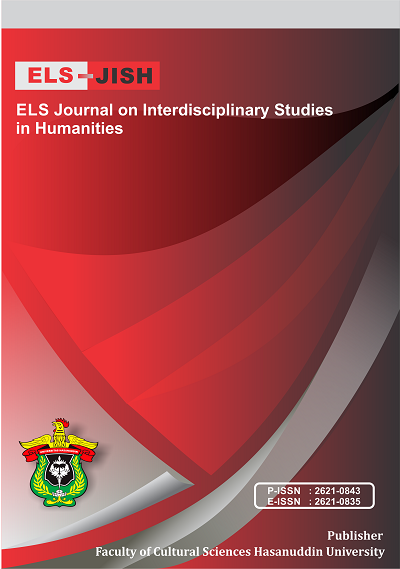Destructive Environmental Discourse: An Author's Writing Strategy in Children's Stories
DOI:
https://doi.org/10.34050/elsjish.v6i3.28202Keywords:
Children's story writer, Destructive, Environmental discourse, Ecolinguistic, Writing StrategyAbstract
This article aims to describe the discourse of the destructive environment found in the book Indonesian Children's Stories of Choice and explain the presence of destructive environmental discourses as an author's writing strategy. Environmental discourse is a subject of special attention in studying language related to the environment. This study uses the Ecolinguistic theory of the story we lived by Arran Stibbe. Environment discourse is stories that live in a community environment that influences and even determines one's mind. The environment consists of constructive and descriptive discourse. This study focuses on destructive environmental discourse, i.e., disasters containing information that violates or opposes environmental conservation values. The results of this study indicate that destructive environments are one of the authors' writing strategies for punishing characters in stories that contradict the environmental values of intelligence. In addition, the discourse of environmental destruction is created to be the reason for the presence of the discourses of resistance that are constructive and on the side of the wisdom of the environment. This study concludes that the authors use the environmental disasters as part of the message of the story to be known so as not to be done or followed by readers, especially readers from among children.
References
Akhmar, A. M., Rahman, F., Supratman, S., Hasyim, H., & Nawir, M. (2022). Poured from the sky: The story of traditional ecological knowledge in Cérékang Forest conservation. Forest and Society, 6(2), 527-546. http://dx.doi.org/10.24259/fs.v6i2.15176
Andini, C. (2017). Children Emotion in The Movie" Big Hero 6 (Doctoral dissertation, Doctoral dissertation, Universitas Islam Negeri Alauddin Makassar).
Burnes, D. (2016). The Gothic in Children's Literature: The Creation of the Adolescent in Crossover Fiction (Doctoral dissertation, University of Sheffield).
Fill, A., & Muhlhausler, P. (Eds.). (2006). Ecolinguistics reader: Language, ecology and environment. A&C Black.
Goga, N. (2018). Children’s literature as an exercise in ecological thinking. Ecocritical Perspectives on Children's Texts and Cultures: Nordic Dialogues, 57-71.
Halliday, M. A. (1990). The Place of Dialogue in Children's Construction of Meaning. ERIC - Education Resources Information Center.
Haugen, E. (1972). The Ecology of Language. Stanford, Cal.: Stanford University Press.
Hunt. P. (1992). Literature for Children: Contemporary Criticism, London: Routledge.
Hunt, P. (2003). Literature for children. Routledge.
Junaid, S., Ahmad, Nurhidayah, Mujizat, A., & Andini, C. (2023). The Quality of Human and Non-Human Relation in Indonesia and England Portrayed in the Selected Picture Books. ELS Journal on Interdisciplinary Studies in Humanities, 6(2), 211-218.
Jumiati, Rahman, F., Lewa, I., Akhmar, A. M. (2022). The Potential of Children’s Literature in Educatioan and Environmental Ethics: Linguistic and Literary Approaches, Proceedings of the 1st International Conference on Research in Social Sciences and Humanities (ICoRSH 2020).
Kadir, H. (2016). Penokohan Superego Anak Didik melalui Kegiatan Membaca Karya Sastra Anak. Universitas Negeri Gorontalo.
Lanta, J., Rahman, F., Lewa, I., & Akhmar, A. M. (2022). Respect for Nature in Indonesian Children’s Fiction: Ecocriticism Perspective. Webology, 19(1), 6010-6021.
Liliani, E. (2015). Konstruksi gender dalam novel-novel anak karya penulis anak. LITERA, 14(1).
Nuzwaty. (2019). Pengenalan Awal Ekolinguistik. Medan: Sastra UISU Press.
Rahman, F. (2014). Iconic Forces of Rhetorical Figures in Shakespeare’s Selected Drama. Universitas Hasanuddin.
Rahman, F., & Weda, S. (2018). Students’ perceptions in appreciating English literary works through critical comment: A case study at Hasanuddin University and Universitas Negeri Makassar. Asian EFL Journal, 20(3), 149-172.
Santoso, A. (2022). Melihat Sastra Anak Dunia Sebagai Alat Perjuangan Ideologi. Semiotika: Jurnal Ilmu Sastra dan Linguistik, 23(2), 123-135. https://jurnal.unej.ac.id/index.php/SEMIOTIKA/index
Stibbe, A. (2015). Ecolinguistics Language, Ecology and the Stories We Live By. New York: Taylor & Francis Books.
Wulanesti D.J. (2021). Sikap Ideologis dalam Empat Novel Anak Karya Roald Dahl. Bandung: Universitas Padjajaran.
Zakaria, P. R., & Harun, M. (2019). Analisis Unsur Cerita Fiksi Anak Putri Kaul Karya Herman RN dan Putri Betung & Gajah Putih Karya Rismawati. Master Bahasa, 7(2), 364-374.
Downloads
Published
Issue
Section
License
Copyright (c) 2023 Jumiati Lanta, Andi Muhamamd Akhmar, Inriati Lewa, M. Nurzin R Kasau

This work is licensed under a Creative Commons Attribution-ShareAlike 4.0 International License.






